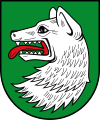Hurled
|
Hurled
City of Brilon
|
|
|---|---|
| Coordinates: 51 ° 26 ′ 0 ″ N , 8 ° 35 ′ 10 ″ E | |
| Height : | 449 m above sea level NN |
| Area : | 2.59 km² |
| Residents : | 401 (Dec. 31, 2013) |
| Population density : | 155 inhabitants / km² |
| Incorporation : | 1st January 1975 |
| Postal code : | 59929 |
| Area code : | 02961 |
|
Location of the village of Wülfte within the urban area of Brilon
|
|
|
Aerial photo (2013)
|
|
Wülfte is a northern district of the city of Brilon in the Hochsauerlandkreis , Germany . The municipality, which was independent until 1974, has 401 inhabitants (as of December 31, 2013).
geography
Wüflte is located about 4.5 km north of Brilon city center on the north-western edge of the Brilon plateau . To the north-west of the village, this merges into the forested eastern extensions of the hair strand . In the southwest, the Möhne and its source streams separate the Haarstrang from the eastern foothills of the Arnsberg Forest . To the east is the protected landscape component in the hall . In the northeast, the terrain slopes down into the valley of the upper Alme . The village has an altitude of 430 to 470 m above sea level. NN . The highest point in the immediate vicinity is the Bulstern ( 482.3 m ).
The closest places in the area are the Brilon districts of Alme in the northeast, Nehden in the east, Thülen in the southeast, Brilon's core town in the south and Scharfenberg in the west. The town of Rüthen is located about eleven kilometers to the northwest .
history
Wülfte can be traced back to the Neuenheerse Monastery since 1248. In the following years, however, it increasingly became a Brilon town village. The village, which was temporarily abandoned in the 15th and 17th centuries, only became an independent municipality in the Thulen district in 1837 .
On August 22, 1998, the Wülfter celebrated their 750th anniversary in the village.
During the Second World War , a burning enemy plane crashed at the Wülfter quarry. From March 26 to 29, 1945 the village was occupied by a transport unit of the Wehrmacht . From March 29th, residents of Wülftes were able to observe units of the US Army on the streets around the village. On Easter Sunday, April 2, 1945, US troops entered the village and moved on after ten days. In the following time there were raids and looting of former prisoners from the Soviet Union.
31 Wülfter died as soldiers in World War II, most of them on the Eastern Front , or died in captivity.
With the municipal reorganization in North Rhine-Westphalia , Wülfte became a district of the city of Brilon on January 1, 1975. 410 inhabitants now live in the rural village at the gates of the city.
politics
coat of arms

|
Blazon : In green, a silver wolf's head with a red tongue. Description: The wolf's head as a shield figure is a so-called "talking coat of arms" that reflects the name of the place. The official approval took place on November 11, 1954. |
Attractions
The listed St. Anna Chapel and the hiking trail W1 around Wüfte with the Bulsterkopf viewpoint are worth seeing.
The St. Anna Chapel was built in 1690 at the instigation of Bartholomäus Gerwins, priest of the Teutonic Order from Wülfte.
societies
- The Spielmannszug Wülfte was founded in 1975. He has 36 musicians between the ages of 10 and 55.
- The St. Anna Schützenbruderschaft is the largest association in the village; almost all of the male residents are members. The shooting festival traditionally takes place on the name day of the patroness, July 26th.
- The Wülfte volunteer fire brigade was founded on August 28, 1942. It consists of 16 emergency services and 5 comrades in the honorary department. The fire station was inaugurated on September 21, 1959 and houses the Wülfter fire engine and the historic hand pump.
- The Wülfte women's meeting place is managed by a board that organizes activities several times a year.
literature
- Hugo Cramer: The district of Brilon in the Second World War 1939-1945 - reports from many employees from all over the district. Josefs-Druckerei, Bigge 1955.
Individual evidence
- ↑ Population statistics December 31, 2013. (PDF) City of Brilon, accessed on January 18, 2014 (10.8 kB).
- ↑ a b Topographic map 1: 25,000
- ↑ Gerhard Brökel: 750 years of Wülfte_Festre speech by Gerhard Brökel . Ed .: Dorfgemeinschaft Wülfte. Wülfte August 22, 1998, p. 31 .
- ^ Hugo Cramer: The district of Brilon in the Second World War 1939-1945 . 1955, section Wülfte, pp. 65-66.
- ^ Hugo Cramer: The district of Brilon in the Second World War 1939-1945 . 1955, honor roll section Wülfte, pp. 246–247.
- ^ Federal Statistical Office (ed.): Historical municipality directory for the Federal Republic of Germany. Name, border and key number changes in municipalities, counties and administrative districts from May 27, 1970 to December 31, 1982 . W. Kohlhammer, Stuttgart / Mainz 1983, ISBN 3-17-003263-1 , p. 332 .
- ^ City of Brilon: Population statistics (accessed on January 22, 2013). (PDF; 279 kB)
- ^ Eduard Belke, Alfred Bruns, Helmut Müller: Communal coats of arms of the Duchy of Westphalia, Kurkölnisches Sauerland . Ed .: Sauerländer Heimatbund e. V. Strobel, Arnsberg 1986, ISBN 3-87793-017-4 , p. 178 .
- ↑ Gerhard Brökel: 300 years of St. Anna Chapel in Wülfte 1690-1990 . Ed .: Propsteipfarrgemeinde St.Petrus and Andreas Brilon. Wülfte May 26, 1990, p. 95 .





